The Best Deals on Camping, Backpacking and Outdoor Gear [June 2025]
Break out the sustainable insulated jackets because winter is here! At least here in Utah. But we’re OK with that, because winter and snow means we have the opportunity to play outside in ways we can’t the rest of the year: skiing, snowboarding, snowshoeing, all that good stuff. But winter also means it’s time to break out the layers, especially if you plan to go hiking, cross country skiing, or any other activity where you’ll be working hard in the cold but also need to stay warm when you stop for a snack break.
So we tested out a bunch of the best insulated jackets–all synthetic, all PFAS-free, all more sustainable options–to help you figure out which one is right for you and your specific type of adventure preferences, whether you’re cross country skiing or hiking in the cold. (And if you want even more options, check out these 7 puffy jackets we reviewed last year or 4 hybrid jackets we reviewed this month!) Here are some of our newest favorite sustainable insulated jackets for all your winter pursuits.
Sustainable Insulated Jackets
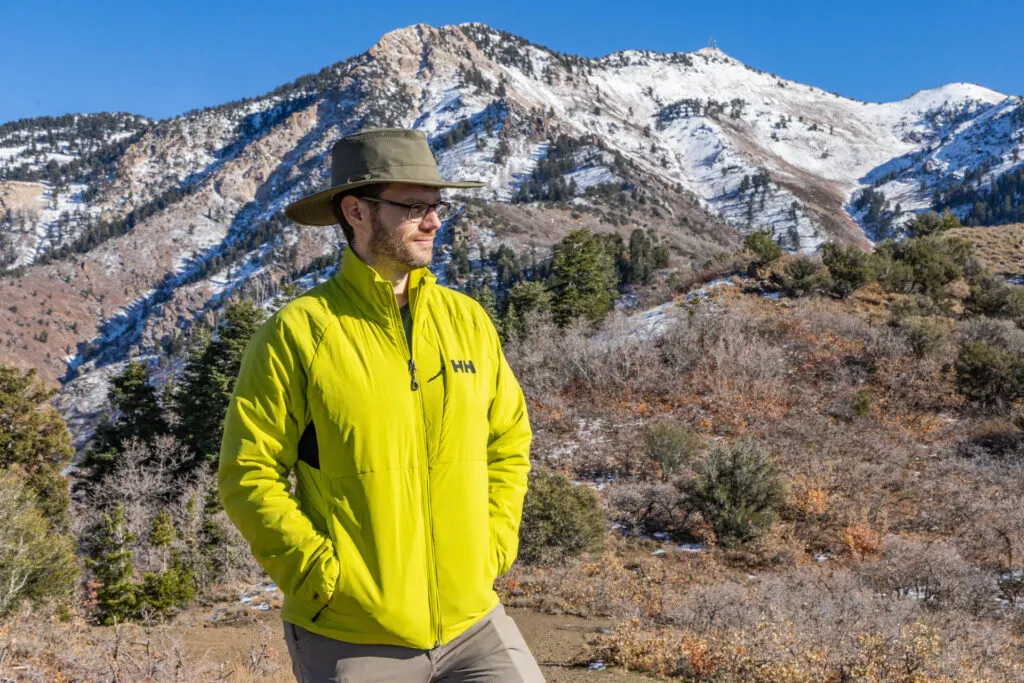
Helly Hansen Odin Stretch Insulated Jacket 2.0
The Helly Hansen Odin Stretch Insulated Jacket 2.0 is an awesome all-around, do-it-all insulated hiking jacket with plenty of features we love, including small stretchy panels just under the arms that offer a bit more breathability, but also freedom of motion, which makes sense, because Helly Hansen designs their gear for mountain pursuits. You know, mountaineering and backcountry skiing and such. But it also just makes a great hiking jacket.
It doesn’t offer the kind of stretch you might find in a hybrid jacket, but I always welcome a bit more breathability. It’s hoodless, which makes it easy to layer–though there’s also a hooded version available–and the fabric feels durable and has just the right amount of stretch, which is nice and makes it perfect for activities where you’re hyper mobile.
There’s a cinch cord in the waist and the zippered hand pockets AND the low-profile chest pocket are designed to lay mostly flat, which keeps it from feeling too bulky under a shell. Frankly, all the details on this jacket make it feel very high quality. The cuffs are unique: they’re more of a hidden, wide, comfy, stretchy band that’s kinda tucked up under the end of the sleeve a bit. It seems like a way to extend insulation all the way down the sleeve, but also keeps it less loosey-goosey around your wrist.
The Odin calls on recycled sheet insulation instead of a down-like flake insulation, which personally I don’t have a problem with because that means you won’t have as many cold spots from stitching or shifting insulation bunching up anywhere. Plus most of the jacket is made of recycled materials, including 100% of the outer fabric and 55% of the insulation, plus it’s Bluesign approved and has a PFC-free water repellent treatment.
It’s slightly fitted, but there’s still plenty of room to layer it over a fitted base layer or two. Anything more than that and I would size up. But honestly, this might be my new favorite jacket for layering AND as an outer layer for cool days.
Size, Weight, Colors: It comes in a S to XXL for men and an XS to XL for women. There are a few color options for both and a men’s medium weighs about 17.5 oz, give or take.
Pros
- Small stretchy panels offer range of motion and breathability
- Supremely high-quality materials and design
- Hoodless for easy layering
Cons
- Only partially recycled synthetic insulation
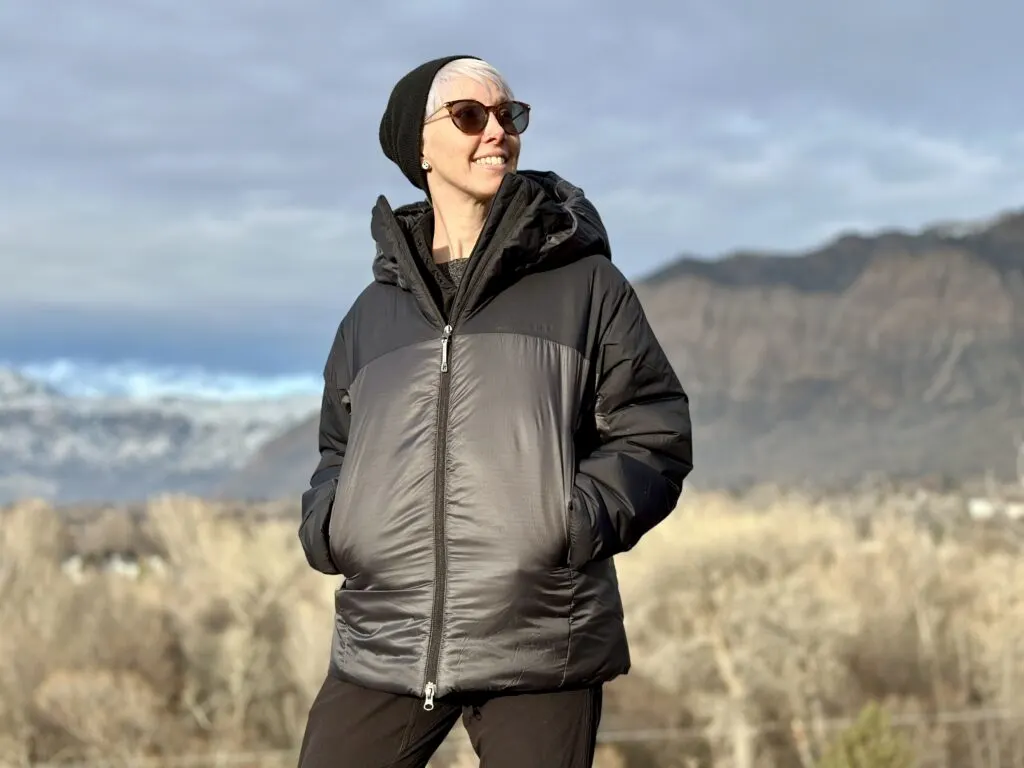
Houdini Double Dunfri
Looking for the reining champ of all puffer jackets? This is the crazy cozy Houdini Double Dunfri. It’s just as delightfully soft as the original Dunfri (which we reviewed in this post and video), but with twice the insulation, making it one of the warmest insulated jackets on this list and an excellent sustainable winter jacket when you’re hiking, backpacking, skiing, you name it.
The hood is ridiculously insulated and roomy, in the best way possible, plus features a two-way adjustment for a perfect fit. The hem is also adjustable via bungees, there are two zippered hand pockets, two massive interior mesh stash pockets, AND an interior zipper pocket for valuables. Oh, and the hand pockets are high enough to stay out of the way of backpack straps and harnesses, by the way. Win.
It obviously isn’t as packable as the original Houdini Dunfri, which is one of Josh’s all-time favorite mid-layers, but it’s still impressively light for how warm it is. I mean, it feels like wearing a puffy cloud. The insulation AND fabric are 100% recycled AND the jacket can be recycled at the end of its life–just send it back to Houdini. That means, yeah, this jacket is circular, which makes this an awesomely sustainable insulated jacket. And yes, it’s PFAS-free and water resistant.
But just as importantly, it’s so soft, comfortable, and warm. The ripstop fabric is soft and the more durable material at the shoulders and on the tops of the arms mean it can also stand up to moderate wear and tear. The fit is a pretty boxy cut, but we don’t care when the jacket is this stupendously cozy. I mean, this is by far the warmest jacket on this list. To the point where I would absolutely wear it on it’s own in winter weather or as a super warm over coat.
It can still be worn over or under a shell, but I do recommend the latter only if your shell is extra roomy. After all, you don’t want to compress the insulation too much or it won’t be as effective. It’s also perfect as a layer you pack to throw on when you take a break during high-output pursuits. Basically, if you’re looking for a super warm layer for really cold days, this is the one. It’s the most expensive one on this list, but if sustainability and warmth are the priority, this is your jacket.
Sizes Available: It comes in XS to XXL for women and men and in 3 mostly neutral colors for both. It weight just over 24 oz for a women’s medium.
Pros
- Super warm
- Light and packable
- Highly sustainable
- Lots of useful features
Cons
- Expensive
- Doesn’t work as well as a mid layer
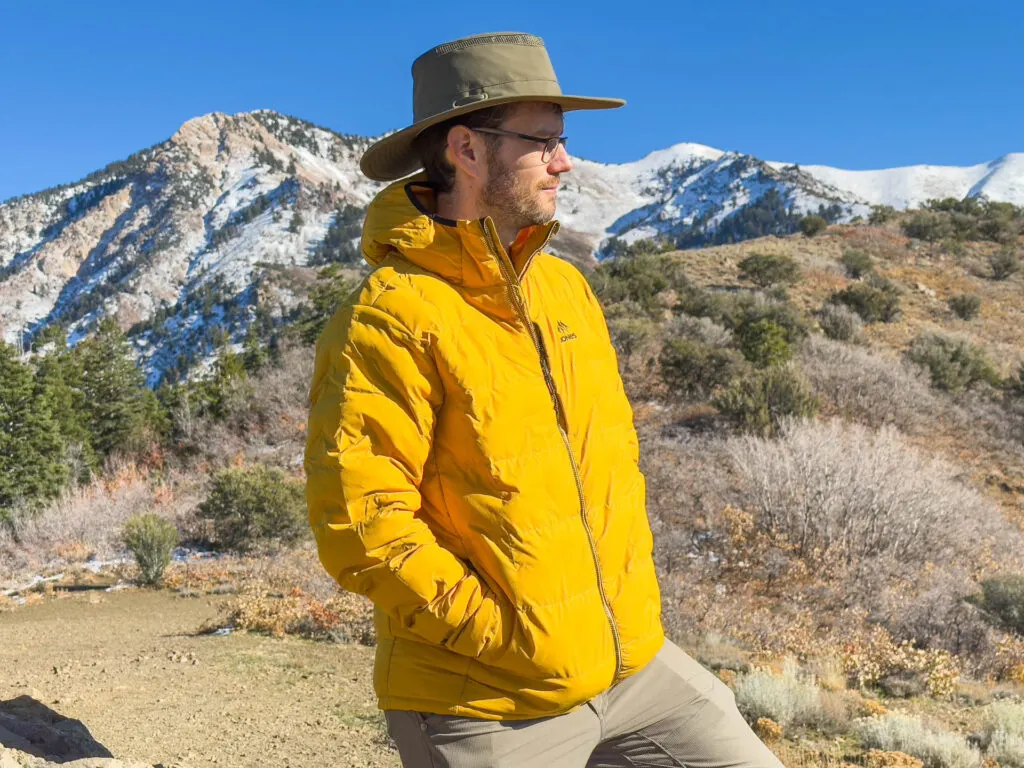
Jones Dark Start Recycled Hoodie
The Jones Dark Start Recycled Hoodie isn’t just for early morning starts (we prefer sunset to sunrise here at Terradrift), but whatever time of day you manage to get out of the house and hit the trail, this jacket performs.
Plus, Jones is a snowboard and winter gear brand that’s super committed to sustainability. For one, they collect and recycle snowboards and process the materials to make new snowboards, which almost no one is doing! But they also offer sustainable apparel, including the Dark Start Hoodie, which is made with 100% recycled fabric AND insulation, plus features PFC-free DWR AND the materials are OEKO-TEX certified.
The jacket has two hand pockets and a zippered chest pocket–which the whole jacket stuffs into for compact stowage (talk about a packable puffer jacket)–plus two interior stash pockets and an adjustable hem. It has a touch of stretch, which makes it a good jacket for layering, and feels supremely breathable, which could be because of how the insulation is placed inside the jacket: there’s a lot of empty space within the sewn baffles, which potentially means a lot of cold spots.
Now, I didn’t feel those cold spots too acutely during testing, but if you’re wearing this jacket on it’s own over just a base layer, say, you will probably notice a difference. A bit more of a chill, that is. I dunno if that insulation will spread out over time or what, but if it does, we’ll let you know. There’s a moderate amount of insulation in there, though, so it’s pretty warm. The fabric doesn’t feel as soft as some of these other jackets, but that’s likely because of the added stretch and frankly, I didn’t mind it. It’s likely more durable, honestly.
It’s designed to wear OVER a shell in addition to under one as an insulating layer, so you can wear it how you want. Not that you couldn’t do that with lots of other jackets…Just, size up if you plan to layer it OVER your shell. Though it’s plenty roomy enough for a layer or two underneath even if you order your usual size. The hood fits just right–snug and secure and definitely stays put. Basically, this one is ideal for cold-weather activities, especially ones where you’ll be on the move like hiking or backcountry skiing and need your layers to breathe.
Sizes Available: Men’s: S-XL, Women’s: XS-L. A medium weighs about 18 oz.
Pros
- Can be worn as a mid- or outer layer
- Stertchy
- Hooded for extra coziness
Cons
- Inconsistent insulation distribution
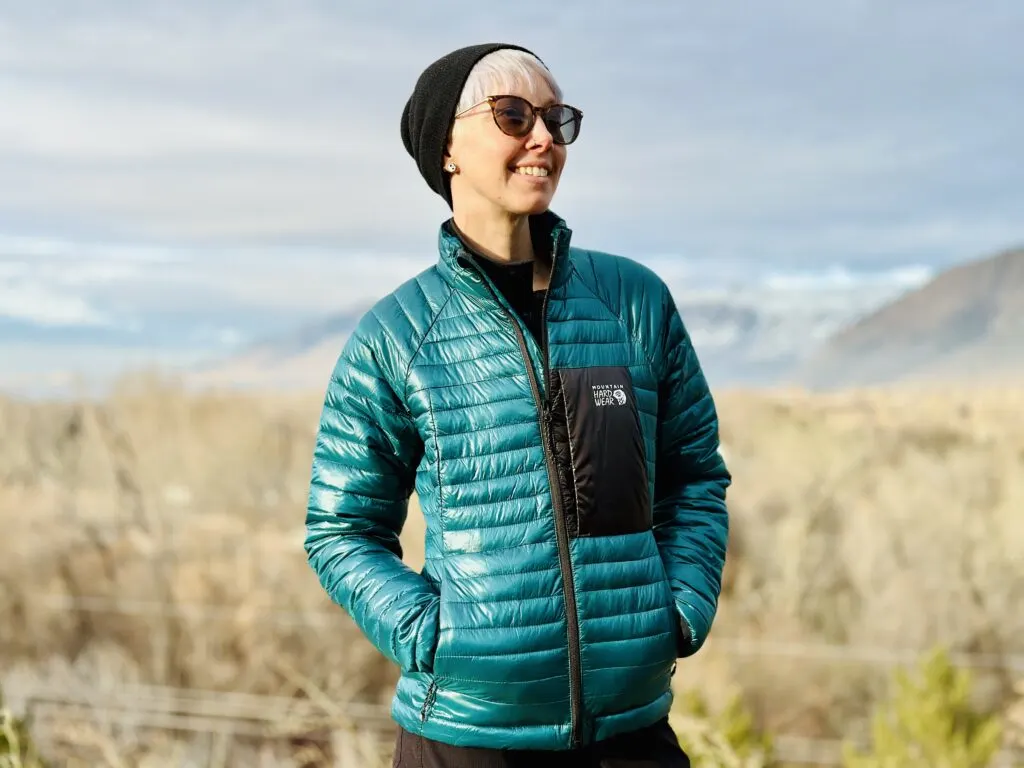
Mountain Hardwear Ventano Review
Looking for a roomier mid-layer that has space underneath for your fave fleece? Check out the Mountain Hardwear Ventano Jacket (there’s also a Ventano Hoodie) The insulation is blown in, which means not only is this particular insulation nice and silky, but it’s nice and fluffy, too. Not that there’s a ton of it: this is more of a winter midlayer or cool-weather outer layer, of course. In any case, it pretty well replicates the softness and loft of down, but, you know, without the animal cruelty.
Also, it’s recycled! The insulation, that is. The outer fabric is a more durable virgin nylon. As for features, this jacket has plenty. For starters, I love the hoodless design. It makes it imminently layer-able. No excess hoods to bunch up and get in the way, ya know? It has two zippered hand pockets–one of which the entire jacket can stuff into for easy portability–AND a nice zippered chest pocket, which I’m always a fan of.
There aren’t any internal drop pockets, BUT! There is a little slot to slide your headphone plug through on the inside of the pocket in case you’re still doing the wired headphone thing. And I’m a fan of this feature: the bungee in the hem is adjustable from inside the pockets AND the ends of those cords have little clips on them. Which means you can easily secure keys or gloves in there so you don’t have to worry about them falling out and getting lost. Huzzah!
As for fit, this insulated jacket runs a bit big (I’m wearing the XS). As in, it’s sized for layering over a thicker shirt or sweater. So if you do plan to layer it over bulkier items like your favorite fleece, don’t be tempted to size up. Just order your normal size, because there’s plenty of extra room in the arms and torso. And I like the available colors, personally. The fabric kinda has a nice, almost iridescent shimmer to it. Very eye-catching.
Sizes Available: It’s available in XS to XL for women and S to XXL for men, plus in a handful of colors for each. It weighs between 10-13 oz on average.
Pros
- Roomier fit
- No hood for easy layering
- Plenty of pockets
- Silky insulation
Cons
- No stretch
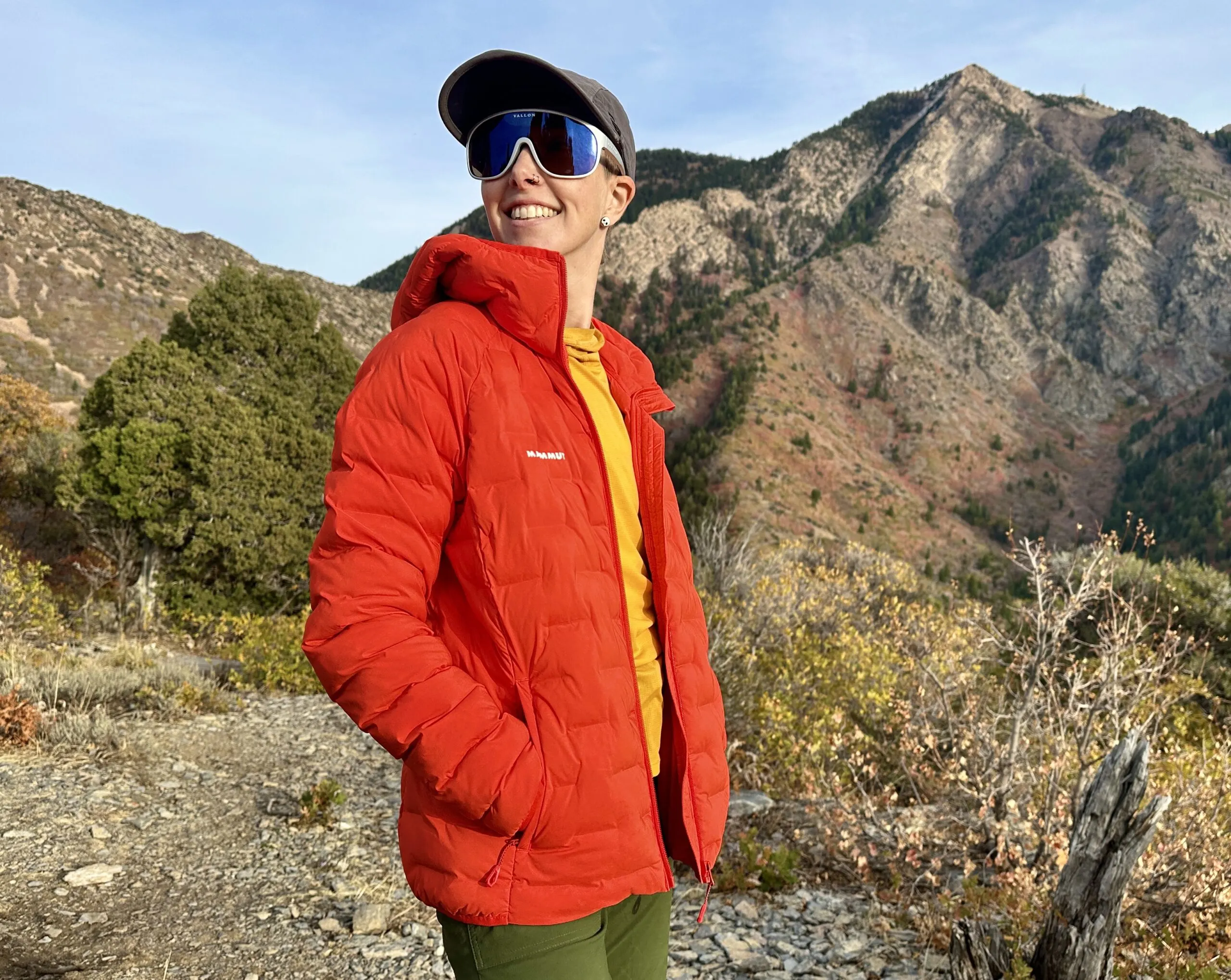
Mammut Sender IN Hooded Jacket
This jacket is designed for alpine adventurers, but will absolutely appeal to hikers, backpackers, climbers and more for a few big reasons: It’s ultra warm, has just the right amount of stretch, and the insulation is made of up cycled climbing rope.
Yup! The synthetic insulation is a first for Mammut: they take off-cuts and unusable climbing ropes, remove the ultra durable core, and turn it into insulation to keep you extra cozy. And this jacket is extra cozy. It may not seem like it’s puffy enough for that, but trust us, it packs a punch. And the built-in stretch? Love. It means you can hike, climb, ride, or do whatever you do without feeling restricted by your jacket, which is extra handy in a layering situation.
And it fits beautifully. The elasticated hood stays put, the sleeves aren’t too long or too short, and it comes in a handful of bomber colors (like this gorgeous lava red). Bonus: zippered hand pockets and interior drop pockets offer plenty of storage space.
One downside: it’s a bit heavier and less compressible than many of the other jackets on this list, so may be better suited for adventures where you’ll be wearing the jacket more than carrying it.
As for sustainability, the outer fabric and lining are made of recycled materials and the insulation is Mammut LOOPINSULATION made from climbing rope scraps. It’s also PFAS-free and Fair Wear certified.
Sizes Available: It’s available in XS to XL for women and S to XXL for men, plus in a handful of colors for each. It weighs between 20-24 oz on average.
Pros
- Quite warm
- Cozy hood
- Plenty of pockets
- Unique up cycled insulation means less waste
- Elasticated hem hem
- Durable fabric
Cons
- No chest pocket
- Heavier and less packable than most options on this list
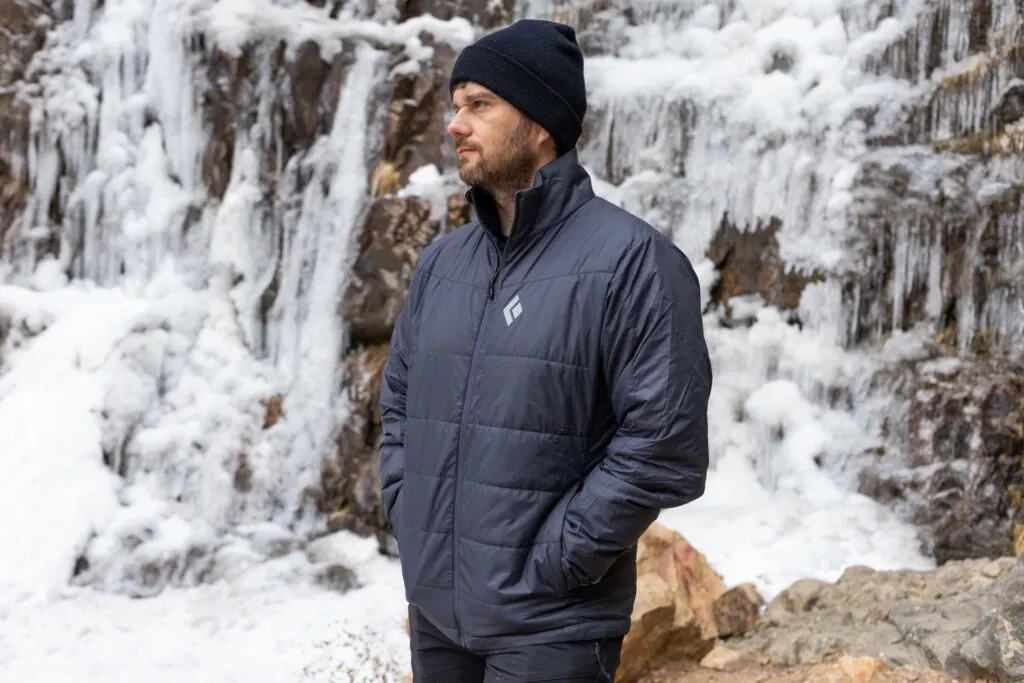
Black Diamond Solution Jacket
The Black Diamond Solution Jacket is a weatherproof, windproof jacket that easily acts as a lightweight outer layer or a cozy mid layer. That’s because it’s both tolerably water resistant and blocks strong breezes but is also anything but bulky, so we found it fits seamlessly under a shell or larger puffy jacket. We first tested it out on a chilly winter hike when temps were close to freezing and while it got a little too sweaty on the long uphill climb, we kept it on because it was so efficient at blocking the cold wind.
Once we reached the top, we threw it on over our base layer and under a nice warm puffy, all of which kept us warm during a nice long break. It’s fitted, but not TOO fitted, the outer fabric feels a bit more durable and scuff-resistant than other jackets we’ve tested, the inner fabric is smooth and non-irritating, and it is comfy.
The DWR is PFAS-free, the hem has an adjustable bungee, and the stretchy cuffs were soft and comfortable. Plus there are two zippered hand pockets and a zippered chest pocket. There’s also a hooded version of the jacket available if you prefer, but we like a non-hooded design when we intend to layer.
As for sustainability, the Solution Hoody is filled with PrimaLoft Gold synthetic insulation made from 100% post-consumer-recycled PET and “Produced Using Reduced Emissions.” The inner and outer materials are also made of recycled materials.
Size, Weight, Colors: It comes in a S to XL for men and an XS to XL for women. There are a few color options for both and a men’s medium weighs about 12 oz, give or take.
Pros
- Stuffs into its own pocket
- Lightweight
- Weather resistant
- Easy to layer
- Hoodless design
Cons
- Not the lightest option
- Not supremely breathable
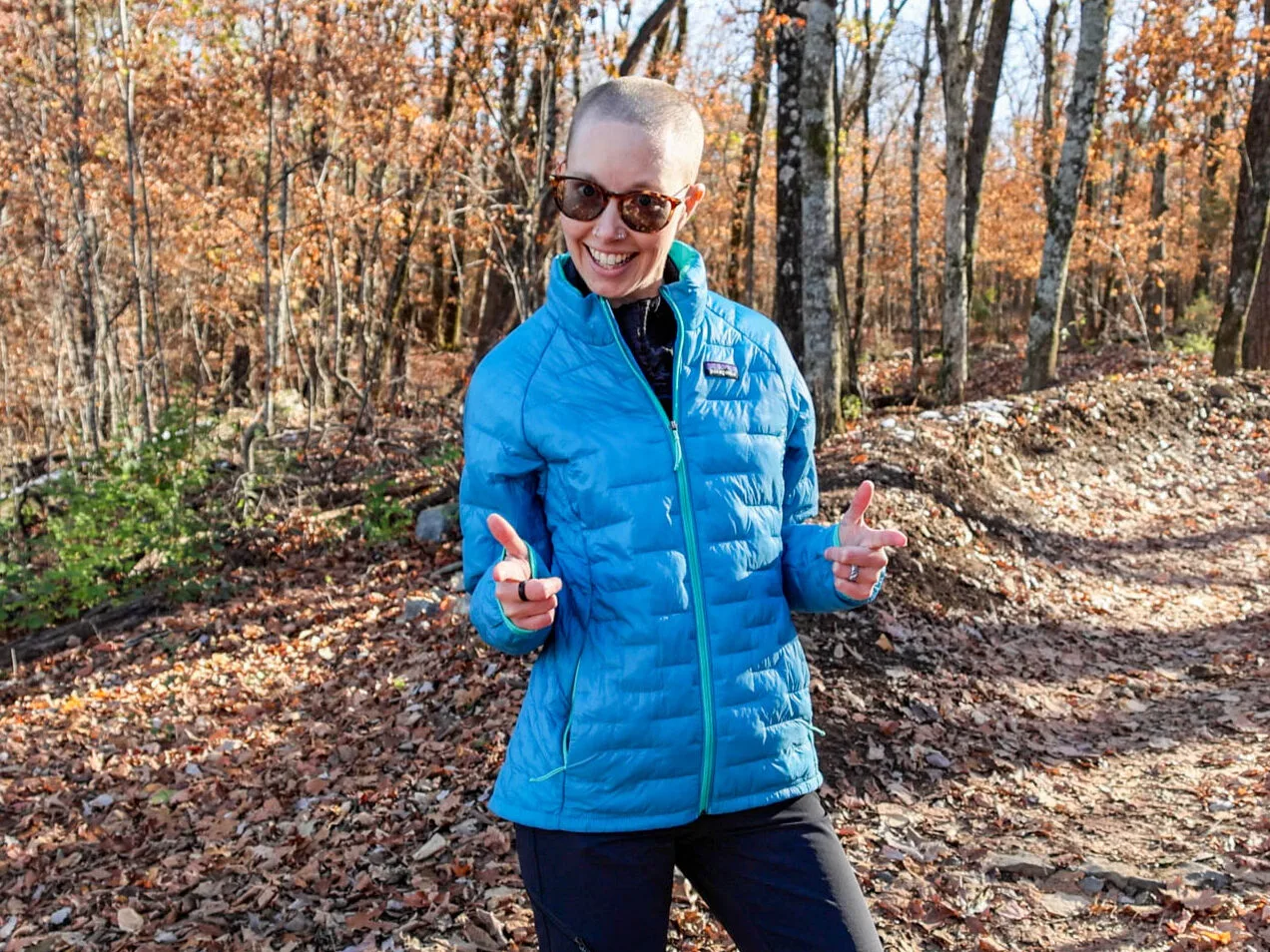
Patagonia Micro Puff
The Patagonia Micro Puff insulated jacket has been around for a while now, but as of this year, it got a major sustainability upgrade: it now features synthetic insulation AND fabric made out of 100% recycled fishing nets! No wonder it’s such a popular insulated jacket for hiking.
That’s a big deal because nets are a notoriously difficult thing to recycle and usually just end up in landfills or floating in the ocean. But the more important factor where wearability is concerned: this is a warmer, lighter, more sustainable Micro Puff than any Micro Puff that’s come before! In fact, according to Patagonia, it features the best warmth-to-weight ratio of ANY jacket they’ve ever made (including down) and has the highest compressibility of any of their synthetic jackets.
Notable features include a bungee at the waist, zippered hand pockets and two internal pockets, plus there’s a hooded version available.
Pros:
- It is impressively thin and light (8.3 oz). The lightest jacket on this list.
- a quality midlayer to wear between your base and outer layers that’s not remotely bulky,
- Super packable
- Impressively sustainable
Cons:
- Not as cozy feeling as some other midlayer jackets
- Fabric isn’t as soft to the touch
Bottom Line
Remember the most sustainable option when it comes to insulated jackets is to repair and re-wear the gear you already have or buy used, but if you must buy new, these are a few of the best insulated jacket options and we hope we helped you figure out which one will suite you and your adventures best.
So gear up responsibly, stay warm out there, and wander on!
